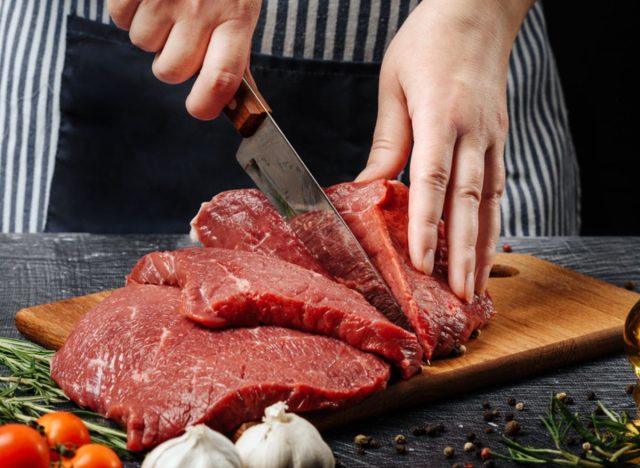7 Chefs' Secrets That Make Restaurant Steak Taste So Good

Moist, juicy, flavorful—restaurant steaks are some of the most coveted dishes. Whether you enjoy a tender filet mignon or prefer a well-marbled ribeye prepared medium-rare, there's a steak out there for every meat lover. However, even though restaurant-made steaks are delicious, they always seem near-impossible to recreate at home. What are their secrets?!
Well, for one if you think buying a steak from that case in your local supermarket will get you there, you're on the wrong track. "Your choice of beef ultimately has more to do with how your steak will taste than the cooking technique," says Malaki Craft, executive chef at Rick Erwin's Clemson.
Craft explains that beef is graded by the USDA, with Prime being the top 10% in the nation, followed by Choice, Select, Standard, and so on. "If you want a restaurant-quality steak, I recommend avoiding Select or Standard grade," he says. Read more about steak grades here.
Choosing the right steak is just the first step to making a restaurant-worthy steak in the comfort of your own kitchen. We enlisted a handful of chefs to help give you tips on how to get the job done. From making sure to use high heat to remembering to cutting like a pro, here are seven chefs' secrets that make restaurant steak taste so much better than the ones you cook at home.
Go to a butcher

Matthias Merges, chef and proprietor of Mordecai Chicago, says that you can also get your steaks right from the butcher for the best quality. "I recommend for home chefs to find a good butcher in their neighborhood and ask for strip steaks, ribeye, or whatever cut they are interested in," he says. He also shares that wet-packed meat should be avoided. "This means the meat will be aged inside a vacuum bag with water to maintain as much weight as possible—this is not something people want to purchase." Instead, go for a piece of meat with firm, white fat and a "dryish" texture.
Add a bit of butter

Tony Sudak, chef and butcher at Walden Local, recommends adding a bit of butter (or "monté au beurre") to the steak towards the end of cooking. "This comes from my French culinary school background," Sudak says. "Monté au beurre means 'mount with butter.' This process adds richness and a bit of flavor to the finished product."
To make an even more delicious steak, Sudak says you can add some crushed garlic cloves, fresh thyme, and fresh rosemary when you add the butter to the pan. "'Voila!' You've just made it to line cook in a high-end steakhouse," he says.
Cut like a pro

If you want to cook like a pro, you also must cut meat like a pro. "When slicing your steak, cut across the grain, or perpendicular to the direction of the fibers, to maximize tenderness," says Chef Lamar Moore, Food Network celebrity chef and winner of the hit TV series Vegas Chef Prize Fight. Moore also says you should avoid piercing the beef with a fork while carving to prevent juices from draining. "Try using tongs to hold it instead while slicing to preserve the juicy goodness!" he adds.
Make sure your steak is at room temperature before cooking

Plan on putting an ice-cold steak on the pan or grill? You may want to rethink this. "Start with a smoking hot pan with olive oil and make sure your steak is at room temperature," says Bravo's Below Deck Mediterranean and celebrity chef Dave White. "Don't take it straight out the fridge and cook it—this is a MUST!"
Be sure to use high heat

Chef Pete Geoghegan, director of culinary at Cargill Protein North America and Sterling Silver Premium Meats chef, says to also use high heat when cooking steak. "You need the grill or skillet to be hot enough to develop that char or browning on the surface of the steaks," Geoghegan says. "You don't want it so hot that it burns but hot enough to create the flavor on the outside."
Allow your steak proper resting time

Don't forget to let your steak rest after cooking. "Resting is also a very important part of properly cooking steaks," says Craft. "Steaks should be cooked within 5 degrees of the desired internal temperature, then removed from heat and allowed 5 to 8 minutes to rest and reabsorb the juices."
Craft warns that cutting a steak before it has had time to rest will cause the juices to run, and the steak to become dry and less flavorful.
Season your steak ahead of time

Sudak explains that you should season your steak ahead of cooking it, "especially if it's a thicker steak closer to 1 1/2- to 2-inches thick," he says.
"A cut that thick, you want the salt to penetrate the meat's interior," he adds. Because of this, it's best to season your steak liberally with salt (and other spices, if you'd like) at least 45 minutes to an hour before cooking. "This will also help purge excess liquid from the steak and aid in the development of the crust," he adds.









